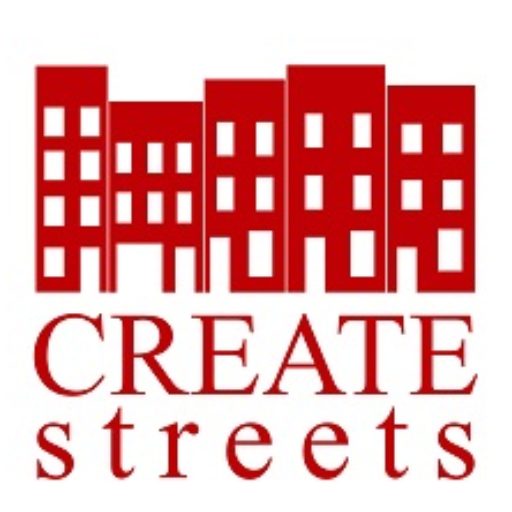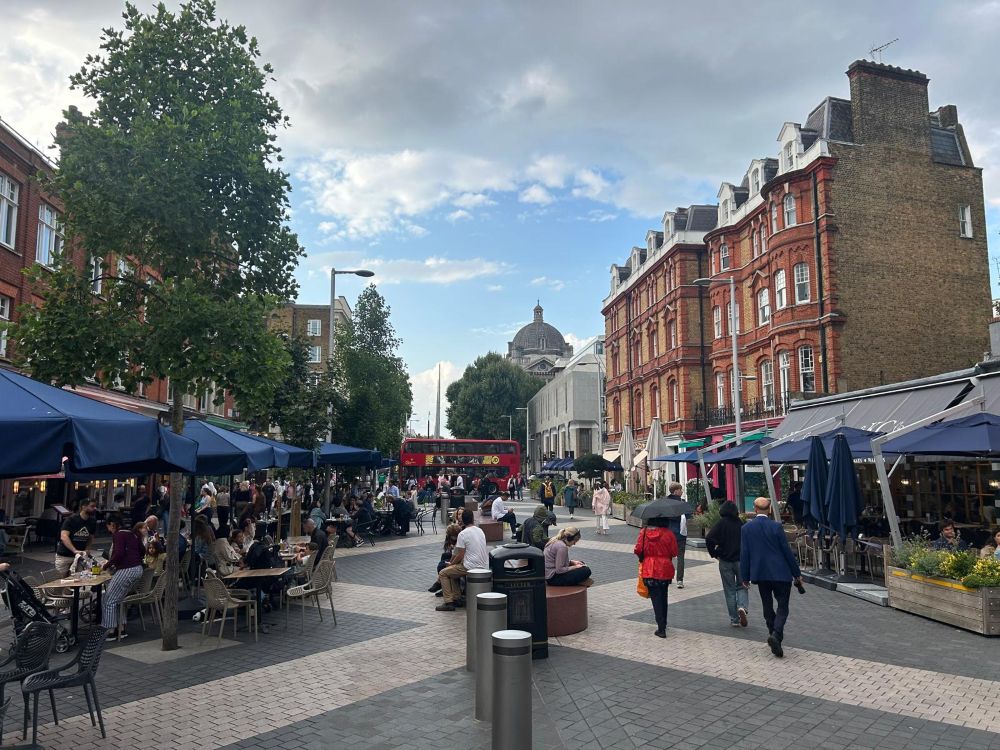Inspired by a visit to Exhibition Road, Nicholas Boys Smith and Eleanor Broad ask what lessons the transformation of Exhibition Road has for Oxford Street’s pedestrianisation
A generation ago, Exhibition Road was a place to avoid, a street that should have been splendid but somehow wasn’t. Broad and generous, and running between the high Victorian museum fantasies of the Natural History, Science and Victoria & Albert Museums what could have been grand was merely grotty. Thin pavements. Lots of people. Lots of cars. A one-way gyratory. Diesel fumes. The south of the road turned into a massive bus station. One restaurant. A few straggling shops.
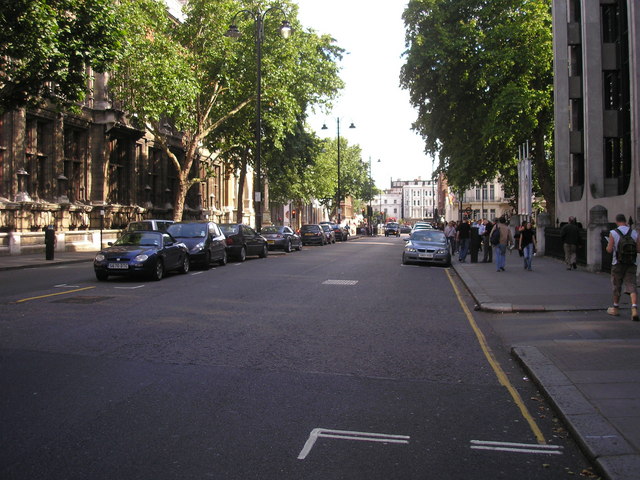
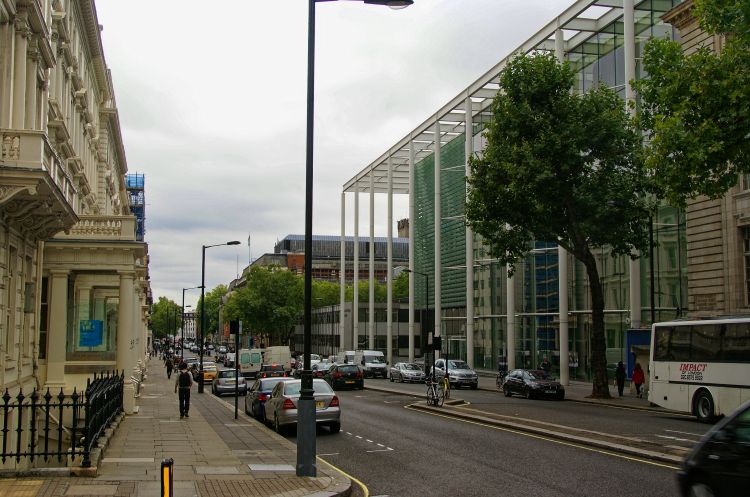
Figure 1 – Exhibition Road as it was[1]
It was not a place to stroll with a toddler or an energised eight-year-old. Visiting the museums as a child, our respective parents normally just avoided it altogether and we walked to the museums through the South Kensington subway, a be-tiled 1880s pedestrian tunnel designed to protect the toffs resident in South Kensington from the passing plebs coming to the museums.
But now all has changed. And changed for generations. Whatever the controversies en route, we’re not going back. Recently, some of the Create Streets team re-visited Exhibition Road guided by Bill Mount, former Group Leader for Transport at the Royal Borough of Kensington & Chelsea (RBKC) and Lead Officer for the Exhibition Road project at the time of the transformation and Toby Anstruther, Chair of South Kensington Estates, owner of many of the retail properties along Exhibition Road. The visit has prompted a few thoughts on the history of Exhibition Road and the future of Oxford Street.
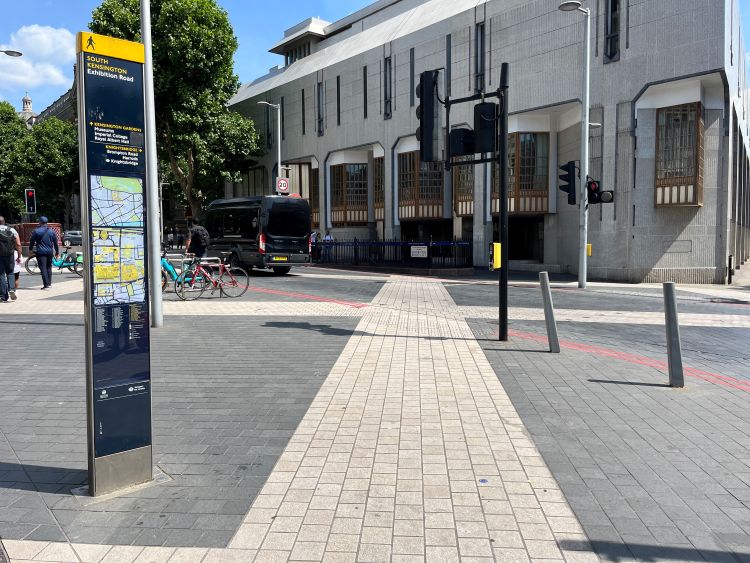
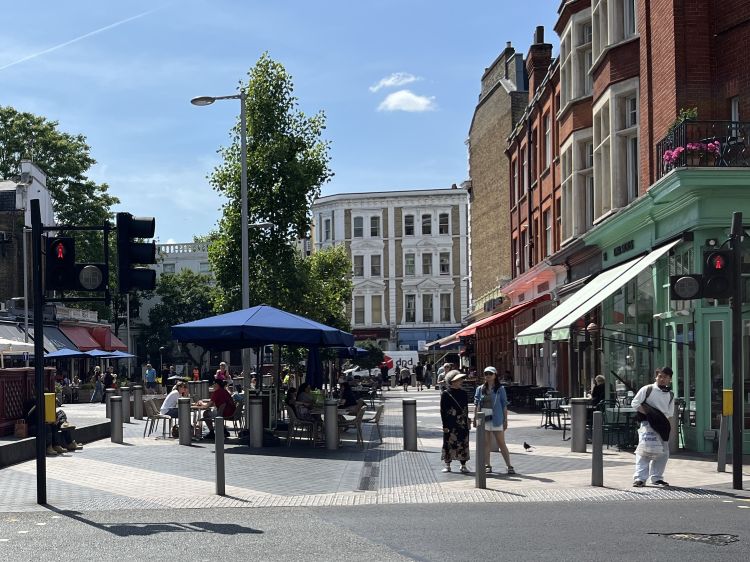
The southern end of Exhibition Road
In 2003, RBKC which manages the bottom two thirds of the street (the top third is managed by the City of Westminster) launched a design competition. The aim was not to pedestrianise Exhibition Road (and indeed it hasn’t been) but to improve it, to reclaim the street as a dignified and safe space and to help it become the boulevard it was trying to be.
It wasn’t quick (nine years). It wasn’t cheap (£20m). And it wasn’t easy (much criticism in some quarters). However, over the next decade, Exhibition Road was unarguably changed beyond recognition. The South Kensington one way gyratory was erased. A 20 mph speed limit was introduced (before it was fashionable). The bus stop was moved and de-concentrated. And, following the Dutch principle of ‘shared space’ with subtle, kerb‑free surfaces to encourage driver awareness, about two thirds of the street was given over to pedestrians. Cluttering signs were stripped out and the whole street was covered in granite with a striking diagonal pattern. The winning designers, Dixon Road were rightly lauded.
The street now instinctively appeals to humans. It was one of the highest scoring streets in a ‘big data’ survey of attractive places that Create Streets ran in 2019. Footfall exploded. Cafe seating doubled. Working together on the southern end of Exhibition Road, RBKC and South Kensington Estates set out to create a “canteen” for the museums. They sought out operators where the focus was informal and good quality and where the owner was still involved (Brindisa had its break here, having been spotted by the team at Borough Market). In return, operators were given turnover rents (relatively unusual at the time) and guaranteed long leases. Restaurants spread like rabbits with commensurate increases in turnover and rentable value. Awards rained down from architectural panjandrums.
Nothing is perfect of course. There was some criticism. Guide Dogs for the Blind spoke of a ‘real problem’ with crossing. There have been a few clashes between Uber drivers and pedestrians but vanishingly few for such a busy place. The ‘de-cluttered’ street has re-cluttered a bit as bollards proliferate to protect pedestrians from the risk of weaponised cars or lorries. And there have been some problems of management with street scars gashing their way through the granite setts. (And why was the granite from China?)
Above all the cost (£20m according to officials involved though higher figures are quoted online) is hard to replicate or emulate. Would a cheaper version have delivered the same for less and proved easier to copy?
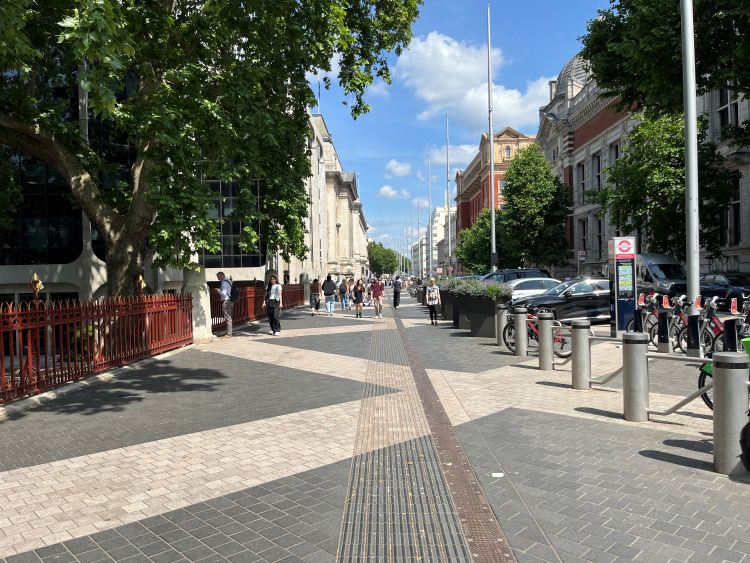
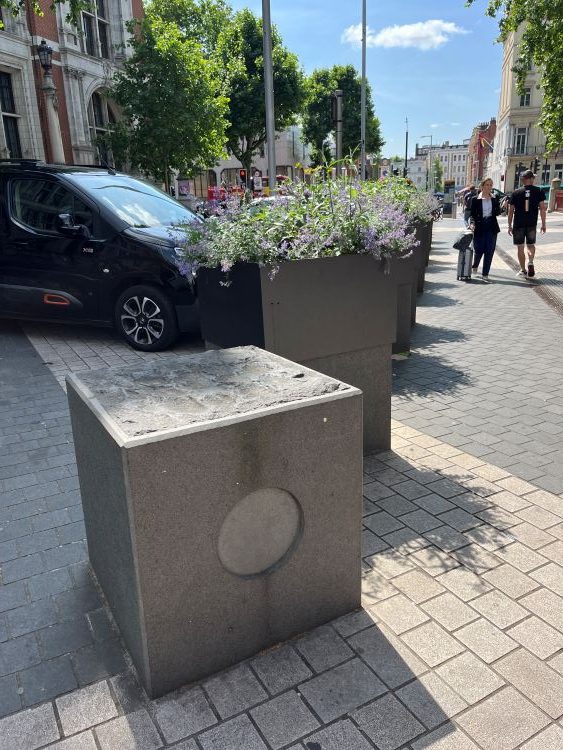
Bollards and granite blocks as hostile vehicle mitigation measures, including integrated bike parking and planting. These still add clutter.
Nevertheless, there are no proposals to revert to the previous street design and speaking to local landowners whose income derives from rented shops, businesses and homes, they are very clear that they would happily see the people-first approach taken on Exhibition Road extended to neighbouring streets. And indeed they would like to grow their “informal, good quality” strategy with a street food market on the northern section of Exhibition Road, so great is demand in the area, with 12 million visitors now a year (versus 7 million over 20 years ago before free entry to the museums was reinstated)
Nor, of course, is Exhibition Road the only major public street to have culturally and economically transformed by redesigning the street. Perhaps the most famous, and earliest major transformation was of Strøget in Copenhagen. First pedestrianised in 1962, it is now one of the longest shopping streets in Europe and one of the most studied. Despite early protests, an insistence that ‘it will not work here’ and death threats against some of the scheme’s progenitors, it was an instant success. Improvements have continued and the street remains a success story. There was a 35 per cent increase in footfall in the first year, a 400 per cent increase in shopping and other activities between 1968 and 1996 and a 600 per cent increase in pedestrian space between 1962 and 2005. Up to 80,000 people a day now use the street to shop, dine or just take in the atmosphere and stroll. The success has spilled out into the rest of Copenhagen. Three times as many people visit the city centre as before.[2]
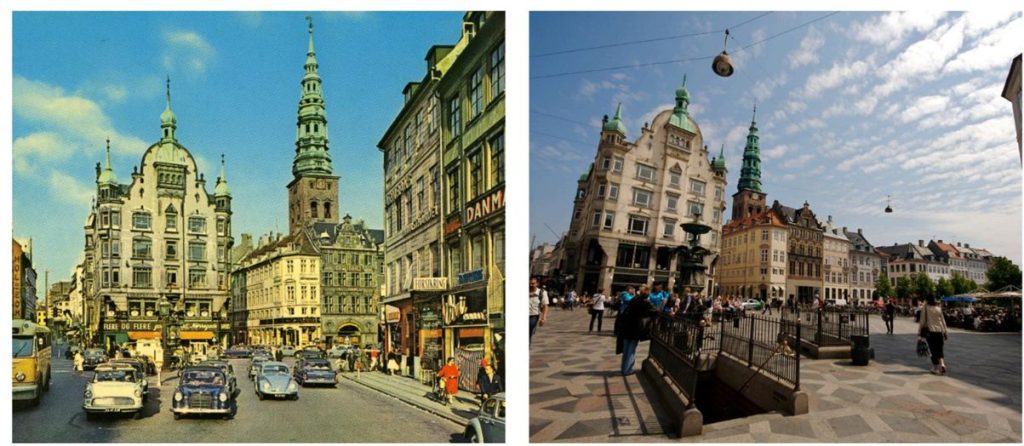
Strøget before and after[3]
Nor is this an isolated example. Create Streets’s study Move Free of movement, street design and the success of streets was unambiguous. Safer and more walkable streets tend to be more culturally and commercially successful. Evidence suggests that, unsurprisingly, people like to go where they can readily mingle with others and go about their daily business safely and pleasurably. The noise, pollution and potential danger of cars, is not conducive to this. Importantly, there is evidence that reduction of traffic in public spaces does lead to more pedestrians and increased social mingling. A wide and growing range of studies in the UK and abroad suggests that this carries through to the commercial success of shops in less car-dominated streets.[4]
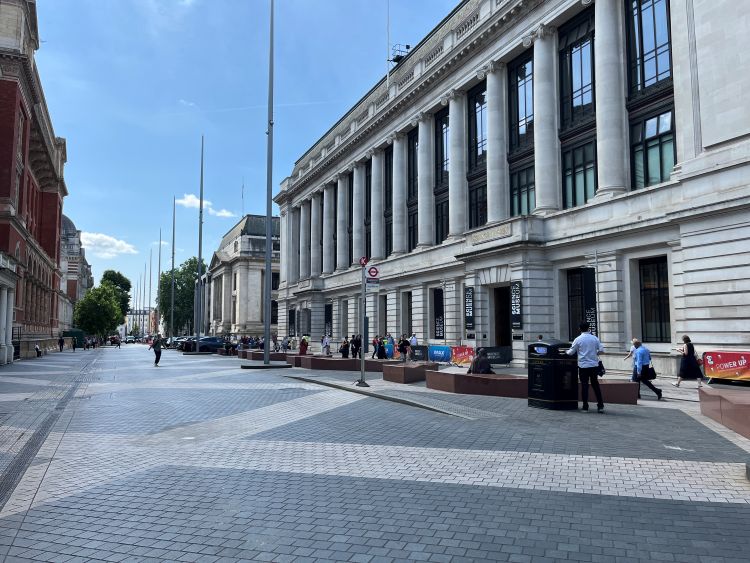
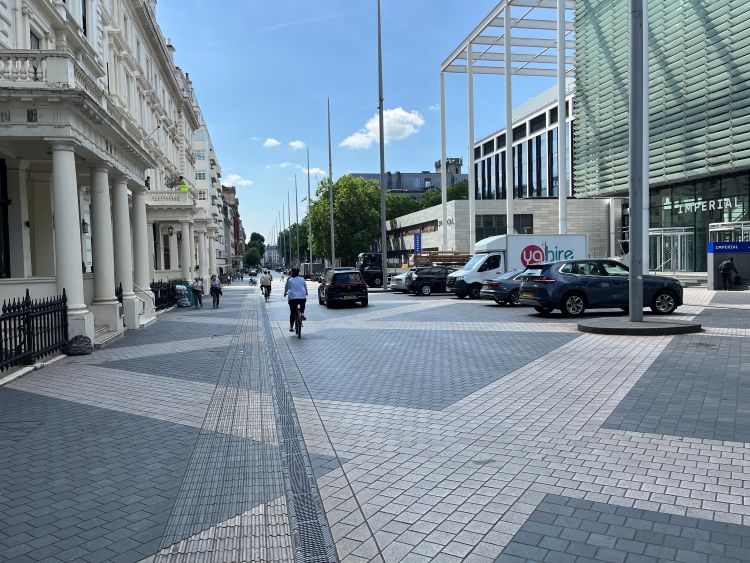
North of Exhibition Road, outside the Science Museum and Imperial College.
Why is this relevant today? In June 2025, the Mayor of London confirmed that he would move ahead with the pedestrianisation of Oxford Street following a consultation in which 66 per cent of those responding to the consulting supported the move. The Mayor summarised his aims, part of his long running focus on improving air quality:
“This is an exciting time for London. Not only can we move forward to create a beautiful public space where people can shop, eat, and connect, but we can also transform Oxford Street into a place Londoners and the whole of the country can be proud of as we continue to build a better London for everyone.” [5]
Based on the experience of Exhibition Road and Create Streets’s wider research and practical work ‘on the ground’ improving streets and places, if Create Streets were writing a note to the Mayor of London or one of his team about getting Oxford Street right, these would be our top tips.
1. “Be visionary not tactical. Pedestrianisation is a step, and a very valuable one, on the path to creating a better neighbourhood at Oxford Street. But it is not, we would suggest, an aim in itself. The aim is to make a better place which people can love, live in, visit and move through with safety and joy. A true legacy needs to think about place not just movement. The two should work hand in glove, with improvements to the way people move delivering improvements to place quality, buildings and levels of enclosure and greenery.
2. What is the name of your aim? The vision for Oxford Street and the surrounding streets needs a name which is about the place not the process. Options might include ‘Oxford Street Breathe’, ‘Oxford Park’ or, as we have suggested before, Elizabeth Town, to commemorate Elizabeth II.[6]
3. Build alliances and speak to different segments. Our research and our project work on behalf of councils, neighbourhoods and landowners consistently shows that it can be much easier to create support for development as long as you talk about vision, beauty, place as well as about movement and more utilitarian considerations.[7] Think widely not narrowly.
4. On consultation and engagement
a. Ask about place not just about movement. The key question is not “do you support pedestrianisation?” but “which place would you rather visit, live in or work in?” Don’t focus questions solely on pedestrianisation but ask about planting street trees, creating more beautiful buildings. Use visual preference surveys alongside more ‘normal’ techniques.
b. Keep it visual not verbal. Use clearly different images of alternative futures and ask which people prefer. Don’t be too conceptual.
c. Come to the people. Don’t expect people to come to you. Reach out on key days (a) on Oxford Street itself and (b) in places from which people should be coming to Oxford Street.
d. Trial and measure. Pedestrianise or part pedestrianise or take other steps on a temporary basis on a given Sunday or bank holiday. Track footfall in comparison to a ‘normal’ Sunday.
5. Keep it simple. The most successful schemes over time are not over-designed. They are simple and elegant. They are built of durable materials that reflect the local area so that people instinctively know where they are (“this must be Oxford Street”). They use trees and benches to help enclose places and frame views. They should speak the language of London’s streets, with a simple palette of materials, ample greenery and elegant furniture. They avoid trendy, overly complex paving. Modish designs become de-moded. Exhibition Road would be better if it were simpler. A pedestrianised Oxford Street should expand London’s language not try to invent a new one.
6. Grow the park and weave greenery throughout. Urban greenery is good for us, good for the planet and good for places. It is also normally popular.[8] Particularly in the context of reversing Park Lane’s 1960s dual carriageway and the mayor’s focus on air quality, the concept of ‘growing the park’ into Oxford Street seems appropriate. Plant trees, flowers and grass. No more ‘Westminster Mound’ gimmicks please.
7. Don’t rely on cartoons to sell your vision. We are not convinced by the imagery that has become the standard ‘short-hand’ in the media for planned changes to Oxford Street. Even at this stage of the project, visuals should be more realistic to convey the feel and texture of Oxford Street. Nor are we convinced by the current cartoon look and feel of the website. Bright colour may grab our attention but it risks feeling gimmicky and short-term which we would suggest is the opposite of the values that should be conveyed.
* * *
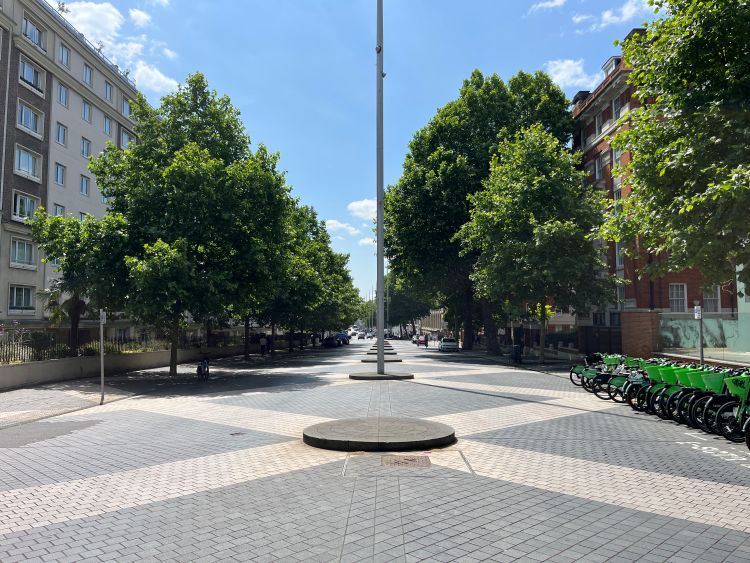
Exhibition Road looking south
A generation ago, Exhibition Road restarted the journey of improving London’s streets to make them easier and more pleasant places to walk and cycle as well as to drive. Despite some controversies en route, that journey has certainly improved London’s prosperity and liveability. But there’s much, more to do !
Nicholas Boys Smith is the founder and Chair of Create Streets
Eleanor Broad is Associate Director at Create Streets
[1] Sources. Left: Sandy Gemmill / Exhibition Road / CC BY-SA 2.0. Right: Txllxt TxllxT / London – Exhibition Road – View South / CC BY-SA 4.0
[2] See Boys Smith, Vadera, Noble, Milner (2024), Move Free, pp.24-25.
[3] Right hand photo Olga Itenberg (CC-BT 2.0)
[4] Boys Smith, Vadera, Noble, Milner (2024), Move Free.
[5] https://www.london.gov.uk/sites/default/files/2025-06/Oxford%20Street%20Transformation%20consultation%20report%20-%20June%202025.pdf
[6] Here is our work on the idea of Elizabeth Town: Elizabeth Town – Create Streets
[7] Example that support our strong point of view on this include our book on popular places (Of Streets and Squares), our pricing research (as summarised in this RICS Journal summary of our study, Beyond Location), our visual preference survey (for example this visual preference survey on our Oxford Street proposals) and our project work (for example here in Lichfield, in Surrey or in Devon) which consistently show that it is possible to achieve public support for pro-pedestrianisation and pro-density policy and proposals if people love it.
[8] You can see our wider research on this here: Greening Up – Create Streets
